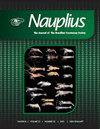Cave-dwellers Diploexochus (Isopoda, Armadillidae): new species and new records of the genus from Brazil
IF 0.8
4区 生物学
Q4 MARINE & FRESHWATER BIOLOGY
引用次数: 2
Abstract
Two new species of Diploexochus are described. Diploexochus spinatus sp. nov. from Lapa do Honorato cave, located in the municipality of Iuiu, and Diploexochus obscurus sp. nov. from Água Escura I cave, located in the municipality of Carinhanha, both in the southwest of Bahia State, northeastern Brazil. Both species are likely to occur in caves due to anthropogenic impacts in the surrounding area (such as deforestation) and/or looking for the stable microclimatic conditions found in the subterranean realm. Additionally, D. echinatus is recorded in a cave in the municipality of Rurópolis, Pará State, northern Brazil. These represent the first records of the genus for subterranean environments.穴居梁龙(等足目,犰狳科):巴西新种及属新记录
本文章由计算机程序翻译,如有差异,请以英文原文为准。
求助全文
约1分钟内获得全文
求助全文

 求助内容:
求助内容: 应助结果提醒方式:
应助结果提醒方式:


